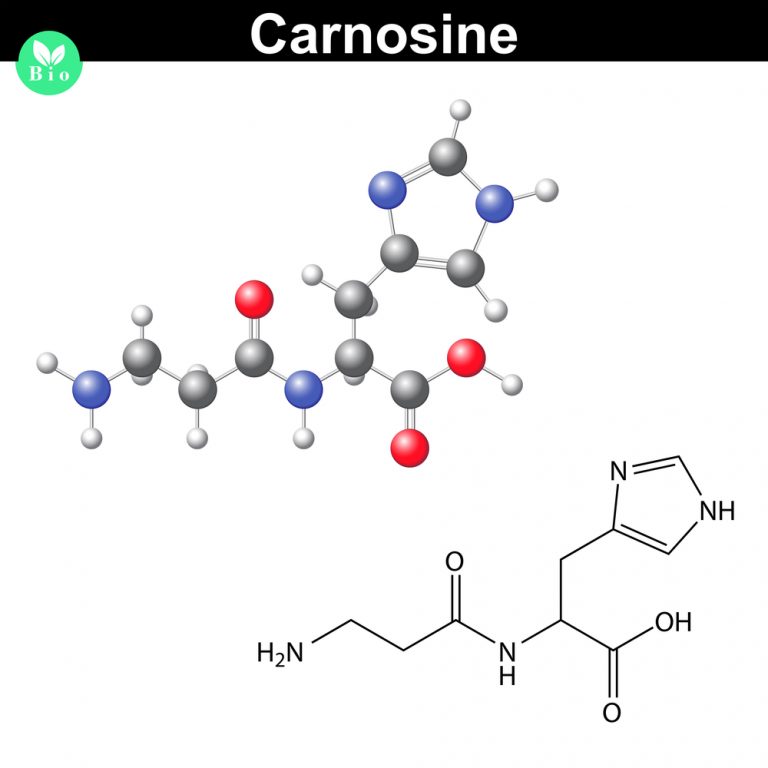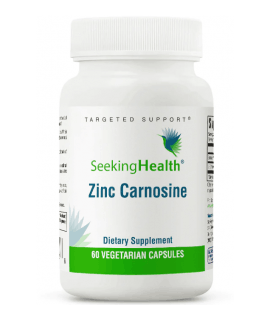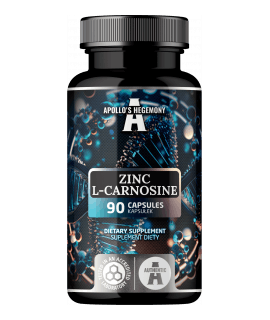What is Carnosine?
Carnosine is the main source of beta-alanine in the body. Its history began more than 100 years ago, in 1900, it was isolated and described by the Russian researcher - Gulewicz. For its synthesis, the presence of L-histidine and beta-alanine is necessary. The absorption of carnosine takes place in the small intestine and during this process it partially hydrolyzes to these components. Currently, it is already known that carnosine belongs to compounds with a very beneficial effect on the body, being at the same time an extremely important source of nitrogen in skeletal muscles of vertebrates. The results of research carried out by scientists indicate that carnosine is a potential therapeutic factor, above all those diseases in which oxidative stress is involved in the pathogenesis (including neurodegenerative, metabolic and cardiovascular diseases). In addition, more and more is being said about itssignificant role in the molecular pathways associated with longevity.All of these speculations seem to be justified. Why?
More than a dozen years after the discovery of carnosine, it was established that it may constitute about 0.2-0.5% of the weight of some striated muscles, it also occurs in other tissues and organs, includingin the central nervous system of mammals, mainly in glial cells and olfactory neurons. Since the synthesis of carnosine in cell cultures of glial cells and skeletal muscle cells is significantly related to the degree of morphological diversity of these cells, it can be assumed that this dipeptide plays a biological role in mature tissues. The action of carnosine is directed to many cells and tissues in order to suppress chemical reactions that prevent proteins from functioning properly. Its content in the body depends on sex (higher level in men), age (carnosine decreases with age) and diet (in people on a vegetarian diet, the level of carnosine in skeletal muscles is low).
Carnosine vs excess glucose
There is often too much sugar in our dietDestructive changes in important enzymes and other proteins caused by glucose in the glycation process (soon I will describe why this process is so important and unfavorable) are one of the main causes of aging and age-related tissue disorders.As a result of these reactions, so-calledadvanced glycation products, from Advanced Glication End nProducts (AGE`s). A strong correlation was found between the concentration of AGEs in the blood and the development and severity of myocardial insufficiency.AGEs and glycation play a key role in the development and progression of cardiovascular disease, causing changes in the structure, function and mechanical properties of tissues. This process occurs in all people (and its effects accumulate over time), but is accelerated in diabetes as a result of constantly elevated glucose levels.It is also very important that glycation is extremely harmful to the brain. Scientific research has shown that in the hippocampus pyramids with increasing age, the amount of AGEs increases, which led to the assumption that glycation must have a significant contribution to neuronal aging and the development of Alzheimer's disease.In another degenerative brain disorder - Pick's disease - the participation of AGEs as the foremost pathogenic factors has been established.In typical for this disease, histopathological changes - in the so-calledPick molecules and balloon cells - the presence of final products of advanced glycation was found. Similarly, glycosylation and AGEs were associated with the development of two consecutive neurodegenerative diseases - Parkinson and Creutzfeldt-Jakob.
The substance which, above all, can prevent or reverse the already existing glycation of proteins, being at the same time a compound that overcomes the aging process is - carnosine. Importantly, carnosine not only captures and deactivates reactive aldehyde compounds, but also reacts with aldehyde groups of proteins altered by glycation. This process determines the carnosylation and consists in the formation of complex aldehyde-carnosine-protein complexes, which are completely devoid of harmful biological activity. In addition, this beneficial dipeptide also significantly removes damaged and pathologically altered proteins from the body. Its operation is based on masking aldehyde groups modified with protein sugars, squeezing in between sugar and protein, thus facilitating the process of proteolysis (removing / decomposing, among others, abnormal proteins). What's more, it supports the activity of structures that are responsible for this process - proteasomes.Therefore, carnosine significantly influences the final elimination of harmful glycation products. Why is this process so important for the proper functioning of the body?Because proteins modified with sugar become resistant to their degradation. Therefore, if the tissues do not have adequate carnosine, harmful glycation products accumulate over time in the muscles, heart and brain, contributing significantly to their degeneration.
The results of a significant amount of scientific research indicate that it is accumulating in the tissues of AGEs, with impaired synthesis of carnosine, is one of the main causes of development of sarcopenia (progressing with age and muscle weakness), heart failure and neurodegenerative brain diseases, thus most pathologies that they accompany the processes of aging of the organism.
Subject of research on life extension
Already nearly 30 years ago, because in the 90s of the last century it was shown that enriching the diet with a carnosine prolongs life expectancy.Since then, the number of studies confirming the multiple, beneficial effects of carnosine is constantly increasing, and its health-promoting activity is being studied in a very wide sense.In 2010, scientists in the magazine Rejuvenation Research shared the surprising results of research on the effect of carnosine on life expectancy. The experiments were carried out on a well-known in the world of science animal model - fruit fly (Drosophila melanogaster).These insects, due to their short life, are of great importance in laboratory research. Especially those that concern genes and the aging process. The researchers observed that adding a very small amount of carnosine to the food of these insects, led to an immediate increase in the average life expectancy in males by nearly 20%.Interestingly, carnosine alone had a small impact on the lifespan of females, but when combined with the water-soluble form of vitamin E, female individuals lived up to 36% longer. The results of these studies are undoubtedly a breakthrough and raise hundreds of questions about this spectacular action of carnosine. Above all, the question arises - why does carnosine cause such an important effect on the aging of the organism and can the effects observed in insects be referred to people?
You shouldn't ever be "too old"!Antioxidative potential
Due to its hydrophilic nature (or hydrophilic "- determines the tendency of chemical molecules to combine with water), carnosine is a valuable supplement to the cytosolic fraction of antioxidant barrier - acts as a water-soluble counterpart of lipophilic (fat-loving) antioxidants - e.g. tocopherol.In in vitro tests (carried out on a research model such as cell lines, tissues) and in vivo (animals), carnosine inactivates oxygen free radicals (hydroxyl and peroxyl radicals) and is a strong scavenger. It inhibits lipid peroxidation (oxidation and damage), thus preventing damage to the protein-lipid membranes.It lowers the concentration of one of the main markers of oxidative stress - malondialdehyde, an important indicator of lipid peroxidation. The protective effect of carnosine on hepatic cells has also been demonstrated in animals that have been exposed to chronic liver damage with ethanol. Carnosine inhibited oxidative damage, secretion of inflammatory mediators.It increased catalase expression, glutathione levels (GSH) and glutathione peroxidase activity.
Importantly, carnosine also has a specific and very important role in tissues that use free radicals in the regulation of biological processes. It can be said that carnosine is a specific buffer of reactive oxygen species in tissues, but what is important - it does not completely inhibit their regulatory and relay functions, but benefits from their benefits. "
Removes toxins - chelates metals
Carnosine has the properties of chelating metal ions (including copper, iron, zinc, cobalt), thanks to which it can regulate their concentration in tissues and body fluids and reduce their toxicity. By binding zinc and copper ions, carnosine affects glutamatergic and GABAergic transmission. It is known that disturbances in the balance of the zinc brain pool are associated with an increased risk of neurological diseases, e.g. Alzheimer's disease (zinc affects the induction of toxic amyloid beta), ischemic stroke and epilepsy.Under experimental conditions, the toxic effects of zinc and copper on neurons of the olfactory bulb have been demonstrated.It is believed that the binding of copper and zinc ions by carnosine may significantly reduce the risk of these diseases.
For the benefit of the heart
Studies have also shown that carnosine can inhibit the activity of the sympathetic nervous system (which is responsible for introducing the state of mobilization and stimulation in the body) affecting hypertension, and thus reduces blood pressure. Thanks to its antioxidant effect, it protects the heart muscle against toxins and adverse effects of chemotherapy, which pose a serious risk to the heart's tissues.The action to eliminate the effects of protein glycation can also help prevent harmful modifications of the LDL cholesterol fraction. This is of great importance in preventing the formation of atherosclerotic plaques in the artery and protecting the blood vessels from damage caused by diabetes. Carnosine has also been shown to improve myocardial contractility through its effects on calcium transmission in the body. It also prevents the oxidation of low molecular weight plasma lipoprotein, which may slow the atherosclerotic processes in arterial vessels.
Role in supporting the nervous system
Scientific research indicates that the brain has high levels of carnosine, capable of reducing oxidative, nitroso (nitric) and glycemic stress, which this body is particularly exposed to.As mentioned earlier, oxidation and glycation leads to inflammation, and also contributes to protein cross-linking, including amyloid beta, which is, in addition to Tau protein, a key brain change in Alzheimer's disease patients.It also helps to minimize the toxicity caused by the high levels of metal ions that are present in certain areas of the brain. Interestingly, in patients suffering from Alzheimer's disease and other neurodegenerative diseases, the level of carnosine is significantly lower, suggesting that either its deficiency contributes to the formation of these diseases or, more likely, disease processes reduce its level. In both cases, one would think that carnosine supplementation would alleviate the majority of cellular toxicity that contributes to the emergence of diseases. Currently carried out (both on animals and on humans) studies clearly indicate the role of carnosine supplementation in the prevention of Parkinson's and Alzheimer's diseases. The unusually interesting action of carnosine also showed in the autism spectrum.In double-blind clinical trials, researchers administered 31 children with autism for 8 weeks to 800 mg / day carnosine.The Gilliam Autism Rating Scale autism rating scale and vocabulary tests were used for the evaluation. Compared to the placebo group, statistically significant differences in autism and one-word vocabulary were observed. The mechanism of action of carnosine is not fully understood, but presumably it improves the functioning of the nervous system in the temporal lobes and frontal cortices of the brain.
Net of neuronsGood meat or supplement - how to deliver carnosine to the body?
Due to the functions performed, the carnosine is degraded and must therefore be reconstituted on an ongoing basis.Unfortunately, the progressing time causes that the body's ability to rebuild it decreases with age. Carnosine is a compound that we find mainly in red meat. A typical meal of red meat can provide 250 mg of carnosine, which, however, by carnosine-degrading enzymes - carnosine is rapidly degraded in the body. Therefore, even the use of a diet rich in good-quality meat, will not ensure its long duration in the body to fulfill its pro-health activity.
Carnosine is used as a dietary supplement with antioxidant activity, delaying cell aging. In addition, it has long been used by athletes as an aid in the regeneration of skeletal muscle, reducing the accumulation of lactic acid and improving muscle contraction.It is worth remembering that the precursor of this dipeptide is - as mentioned - beta alanine known to athletes. Its supplementation significantly raises the level of carnosine in the muscles and increases the buffering capacity that can delay the fatigue of the body.
Multiple and related mechanisms of action of carnosine mean that it can provide benefits to cells and tissues throughout the body that would otherwise undergo the pathological effects of the aging process.Highly concentrated in the brain and muscles is a natural antioxidant and anti-glycation nutrient whose levels in the body decrease with age. It allows to maintain acid-base balance, has antioxidant properties and reduces metal toxicity.
I think it can be said that carnosine is one of the most important compounds found in the body. Due to its unique properties, it can become a supplement supporting the therapy of many diseases, slowing down the aging process and accelerating the process of muscle regeneration.








